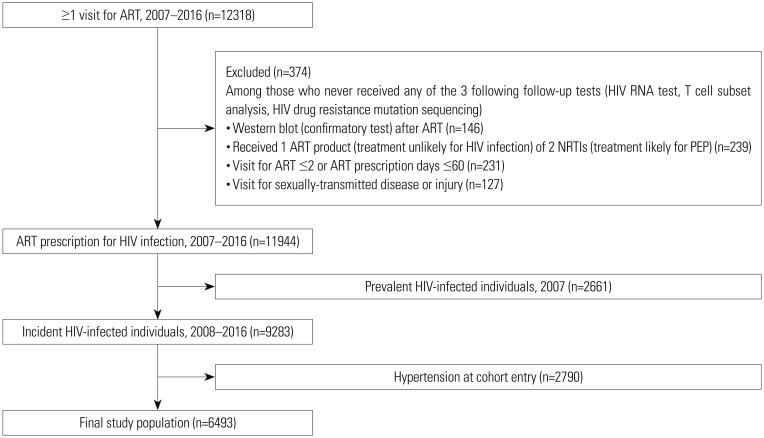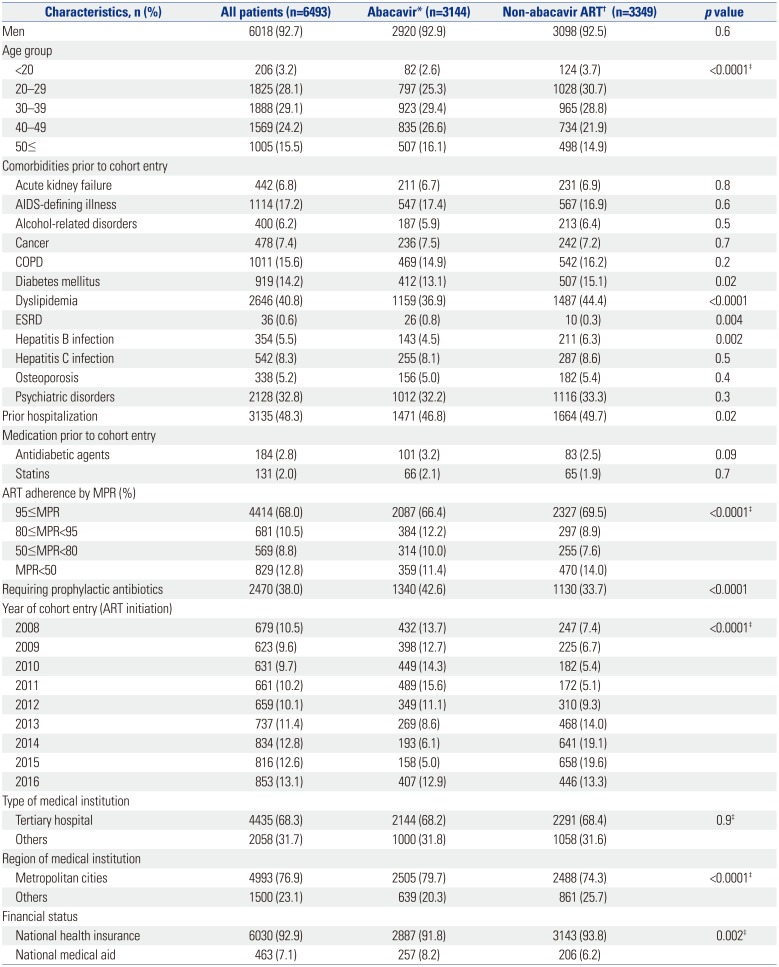1. Calò LA, Caielli P, Maiolino G, Rossi G. Arterial hypertension and cardiovascular risk in HIV-infected patients. J Cardiovasc Med (Hagerstown). 2013; 14:553–558. PMID:
23807242.

2. Armah KA, Chang CC, Baker JV, Ramachandran VS, Budoff MJ, Crane HM, et al. Prehypertension, hypertension, and the risk of acute myocardial infarction in HIV-infected and -uninfected veterans. Clin Infect Dis. 2014; 58:121–129. PMID:
24065316.

3. Nduka CU, Stranges S, Sarki AM, Kimani PK, Uthman OA. Evidence of increased blood pressure and hypertension risk among people living with HIV on antiretroviral therapy: a systematic review with meta-analysis. J Hum Hypertens. 2016; 30:355–362. PMID:
26446389.

4. D:A:D Study Group. Sabin CA, Worm SW, Weber R, Reiss P, El-Sadr W, Dabis F, et al. Use of nucleoside reverse transcriptase inhibitors and risk of myocardial infarction in HIV-infected patients enrolled in the D:A:D study: a multi-cohort collaboration. Lancet. 2008; 371:1417–1426. PMID:
18387667.
5. Martin A, Amin J, Cooper DA, Carr A, Kelleher AD, Bloch M, et al. Abacavir does not affect circulating levels of inflammatory or coagulopathic biomarkers in suppressed HIV: a randomized clinical trial. AIDS. 2010; 24:2657–2663. PMID:
20827168.

6. Martínez E, Larrousse M, Podzamczer D, Pérez I, Gutiérrez F, Loncá M, et al. Abacavir-based therapy does not affect biological mechanisms associated with cardiovascular dysfunction. AIDS. 2010; 24:F1–F9. PMID:
20009917.

7. Wohl DA, Arnoczy G, Fichtenbaum CJ, Campbell T, Taiwo B, Hicks C, et al. Comparison of cardiovascular disease risk markers in HIV-infected patients receiving abacavir and tenofovir: the nucleoside inflammation, coagulation and endothelial function (NICE) study. Antivir Ther. 2014; 19:141–147. PMID:
23985706.

8. Bavinger C, Bendavid E, Niehaus K, Olshen RA, Olkin I, Sundaram V, et al. Risk of cardiovascular disease from antiretroviral therapy for HIV: a systematic review. PLoS One. 2013; 8:e59551. PMID:
23555704.

9. Hatleberg CI, Ryom L, d'Arminio Monforte A, Fontas E, Reiss P, Kirk O, et al. Impact of antiretroviral drugs on hypertension in HIV-positive persons: D:A:D study. In : Conference of Retroviruses and Opportunistic Infections (CROI); 2015 February 23-26; Seattle (WA), USA.
10. Kim J, Shin JY, Lee J, Song HJ, Choi NK, Park BJ. Comparison of the prescribing pattern of bisphosphonate and raloxifene in Korean women with osteoporosis: from a national health insurance claims database. PLoS One. 2015; 10:e0127970. PMID:
26030300.

11. Choi HJ, Park C, Lee YK, Ha YC, Jang S, Shin CS. Risk of fractures in subjects with antihypertensive medications: a nationwide claim study. Int J Cardiol. 2015; 184:62–67. PMID:
25697872.

12. Park JH, Shin Y, Lee SY, Lee SI. Antihypertensive drug medication adherence and its affecting factors in South Korea. Int J Cardiol. 2008; 128:392–398. PMID:
17643514.

13. Kim J, Lee E, Park BJ, Bang JH, Lee JY. Adherence to antiretroviral therapy and factors affecting low medication adherence among incident HIV-infected individuals during 2009-2016: a nationwide study. Sci Rep. 2018; 8:3133. PMID:
29453393.

14. Choi AI, Vittinghoff E, Deeks SG, Weekley CC, Li Y, Shlipak MG. Cardiovascular risks associated with abacavir and tenofovir exposure in HIV-infected persons. AIDS. 2011; 25:1289–1298. PMID:
21516027.

15. Wong C, Gange SJ, Buchacz K, Moore RD, Justice AC, Horberg MA, et al. First occurrence of diabetes, chronic kidney disease, and hypertension among North American HIV-infected adults, 2000-2013. Clin Infect Dis. 2017; 64:459–467. PMID:
28172581.

16. Schneider E, Whitmore S, Glynn KM, Dominguez K, Mitsch A, McKenna MT. Centers for Disease Control and Prevention (CDC). Revised surveillance case definitions for HIV infection among adults, adolescents, and children aged <18 months and for HIV infection and AIDS among children aged 18 months to <13 years— United States, 2008. MMWR Recomm Rep. 2008; 57:1–12.
17. Ryom L, Lundgren JD, El-Sadr WM, Reiss P, Phillips A, Kirk O, et al. Association between cardiovascular disease and contemporarily used protease inhibitors. In : Conference on Retroviruses and Opportunistic Infections (CROI); 2017 February 13-16; Seattle (WA): USA.
18. van Zoest RA, Wit FW, Kooij KW, van der Valk M, Schouten J, Kootstra NA, et al. Higher prevalence of hypertension in HIV-1-infected patients on combination antiretroviral therapy is associated with changes in body composition and prior stavudine exposure. Clin Infect Dis. 2016; 63:205–213. PMID:
27143668.

19. Zapata-Diomedi B, Barendregt JJ, Veerman JL. Population attributable fraction: names, types and issues with incorrect interpretation of relative risks. Br J Sports Med. 2018; 52:212–213. PMID:
26964147.

20. Rockhill B, Newman B, Weinberg C. Use and misuse of population attributable fractions. Am J Public Health. 1998; 88:15–19. PMID:
9584027.

21. Lee JH, Yang DH, Park HS, Cho Y, Jun JE, Park WH, et al. Incidence of hypertension in Korea: 5-year follow-up study. J Korean Med Sci. 2011; 26:1286–1292. PMID:
22022179.

22. Okeke NL, Davy T, Eron JJ, Napravnik S. Hypertension among HIV-infected patients in clinical care, 1996–2013. Clin Infect Dis. 2016; 63:242–248. PMID:
27090989.

23. Lackland DT. Racial differences in hypertension: implications for high blood pressure management. Am J Med Sci. 2014; 348:135–138. PMID:
24983758.

24. Rodríguez-Arbolí E, Mwamelo K, Kalinjuma AV, Furrer H, Hatz C, Tanner M, et al. Incidence and risk factors for hypertension among HIV patients in rural Tanzania-a prospective cohort study. PLoS One. 2017; 12:e0172089. PMID:
28273105.
25. Njelekela M, Muhihi A, Aveika A, Spiegelman D, Hawkins C, Armstrong C, et al. Prevalence of hypertension and its associated risk factors among 34,111 HAART naïve HIV-infected adults in Dar es Salaam, Tanzania. Int J Hypertens. 2016; 2016:5958382. PMID:
27872756.

26. Pirani N, Khiavi FF. Population attributable fraction for cardiovascular diseases risk factors in selected countries: a comparative study. Mater Sociomed. 2017; 29:35–39. PMID:
28484352.

27. Oh DH, Ahn JY, Kim SI, Kim MJ, Woo JH, Kim WJ, et al. Metabolic complications among Korean patients with HIV infection: The Korea HIV/AIDS cohort study. J Korean Med Sci. 2017; 32:1268–1274. PMID:
28665062.

28. DAD Study Group. Friis-Møller N, Reiss P, Sabin CA, Weber R, Monforte Ad, El-Sadr W, et al. Class of antiretroviral drugs and the risk of myocardial infarction. N Engl J Med. 2007; 356:1723–1735. PMID:
17460226.
29. Hui DY. Effects of HIV protease inhibitor therapy on lipid metabolism. Prog Lipid Res. 2003; 42:81–92. PMID:
12547652.

30. McIntosh RC. A meta-analysis of HIV and heart rate variability in the era of antiretroviral therapy. Clin Auton Res. 2016; 26:287–294. PMID:
27395409.

31. Robinson-Papp J, Sharma S, Simpson DM, Morgello S. Autonomic dysfunction is common in HIV and associated with distal symmetric polyneuropathy. J Neurovirol. 2013; 19:172–180. PMID:
23580249.

32. Dorjee K, Baxi SM, Reingold AL, Hubbard A. Risk of cardiovascular events from current, recent, and cumulative exposure to abacavir among persons living with HIV who were receiving antiretroviral therapy in the United States: a cohort study. BMC Infect Dis. 2017; 17:708. PMID:
29078761.

33. Marcus JL, Neugebauer RS, Leyden WA, Chao CR, Xu L, Quesenberry CP Jr, et al. Use of abacavir and risk of cardiovascular disease among HIV-infected individuals. J Acquir Immune Defic Syndr. 2016; 71:413–419. PMID:
26536316.

34. Sabin CA, Reiss P, Ryom L, Phillips AN, Weber R, Law M, et al. Is there continued evidence for an association between abacavir usage and myocardial infarction risk in individuals with HIV? A cohort collaboration. BMC Med. 2016; 14:61. PMID:
27036962.

35. McGoldrick C, Leen CL. The management of dyslipidaemias in antiretroviral-treated HIV infection: a systematic review. HIV Med. 2007; 8:325–334. PMID:
17661840.

36. Suissa S. Immortal time bias in pharmaco-epidemiology. Am J Epidemiol. 2008; 167:492–499. PMID:
18056625.

37. Lang S, Mary-Krause M, Cotte L, Gilquin J, Partisani M, Simon A, et al. Impact of individual antiretroviral drugs on the risk of myocardial infarction in human immunodeficiency virus-infected patients: a case-control study nested within the French Hospital Database on HIV ANRS cohort CO4. Arch Intern Med. 2010; 170:1228–1238. PMID:
20660842.
38. Young J, Xiao Y, Moodie EE, Abrahamowicz M, Klein MB, Bernasconi E, et al. Effect of cumulating exposure to abacavir on the risk of cardiovascular disease events in patients from the Swiss HIV cohort study. J Acquir Immune Defic Syndr. 2015; 69:413–421. PMID:
25932884.

39. Bedimo RJ, Westfall AO, Drechsler H, Vidiella G, Tebas P. Abacavir use and risk of acute myocardial infarction and cerebrovascular events in the highly active antiretroviral therapy era. Clin Infect Dis. 2011; 53:84–91. PMID:
21653308.










 PDF
PDF ePub
ePub Citation
Citation Print
Print



 XML Download
XML Download